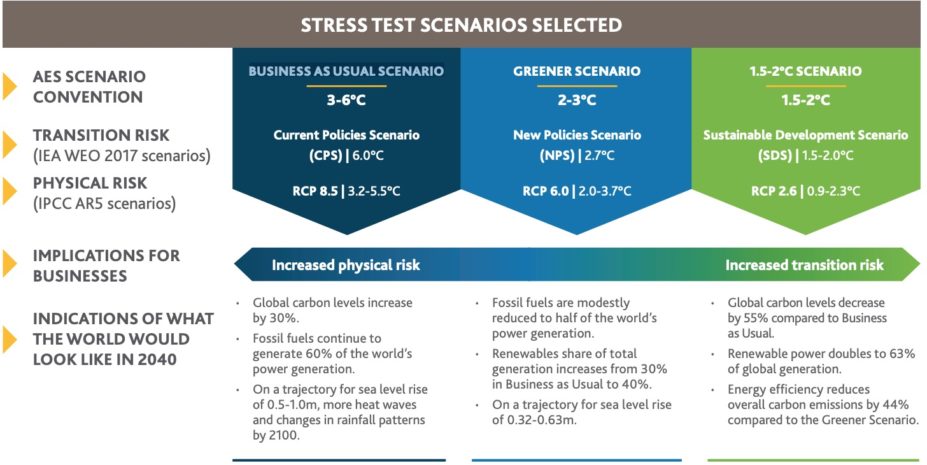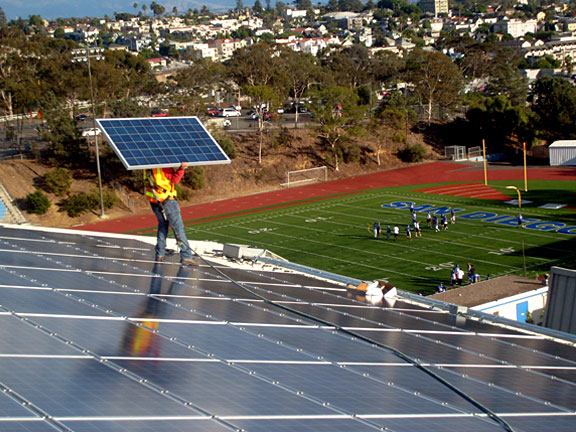AES, one of the world’s largest power companies, has released a report detailing the company’s moves to reduce carbon emissions 70% by 2030, but, more importantly, their plans to incorporate increasing amounts of renewable generation and energy storage projects to compliment this new generation.
In the report, AES outlines three scenarios of optimization between carbon reduction and minimizing the stress of a new energy transition, known as the Business as Usual Scenario, the Greener Scenario and 1.5-2°C Scenario, the same one outlined in the Paris Agreement.

The Greener Scenario is what the company outlines as the the basis for their planning, which is highlighted by the goals of worldwide fossil fuel reduction until these sources represent 50% of the world’s generation and an increase of renewable generation to reach 40% of overall generation.
To do this, AES plans to add another 2-3 GW capacity in renewables annually through 2020. Additionally, the company expects to sign Power Purchase Agreements (PPA) for 7.5 GW of new renewable projects worldwide within the same timeframe. Furthermore, the plan emphasizes the acceleration of energy storage deployment. While no figures for anticipated storage capacity were given, the plan outlines storage as playing a critical role in the transition to a low-carbon energy grid.
AES has been taking steps to reshape its generation portfolio and reduce carbon emissions since 2016. In those two years, AES has added 1.5 GW of renewable generation and gas facilities, as well as signing power PPAs for an additional 1.9 GW of wind and solar. AES currently has a fleet of over 450 MW of battery-based energy storage, highlighted by its 34 MW, five-hour duration, battery-based storage project accompanying a 47 MW solar system on the Hawaiian island of Kaua’i.
The report is influenced by the recommendations of the Task Force on Climate-related Financial Disclosures, a group established in 2015 to develop voluntary, consistent climate-related financial risk disclosures for use by companies.
“We are pleased to be the first publicly-traded U.S.-based energy company to issue a report adopting the TCFD recommendations,” said Gluski. “We are even more pleased to see that the results show our actions make us a more resilient company across various climate scenarios. Working with our customers, we are helping the world transition to a lower carbon energy future by accelerating the acceptance and use of energy storage, energy management and renewables, and extending the use of natural gas to provide a cleaner alternative to other fossil fuels. As a result, we believe AES is climate transition-ready.”
AES is not the only utility giant to be embracing the shift to renewable energy generation. Earlier this week, American Electric Power (AEP), operator of the nation’s largest transmission system, announced that it would be investing $2.7 billion into new renewable generation, $2.2 billion of which will be reserved for competitive, contracted renewable projects.
This comes less than a year after AEP announced plans of its own to cut carbon emissions by 60% of 2000 levels by 2030, with plans to add 8,300 MW of renewable energy to do so.
This content is protected by copyright and may not be reused. If you want to cooperate with us and would like to reuse some of our content, please contact: editors@pv-magazine.com.









By submitting this form you agree to pv magazine using your data for the purposes of publishing your comment.
Your personal data will only be disclosed or otherwise transmitted to third parties for the purposes of spam filtering or if this is necessary for technical maintenance of the website. Any other transfer to third parties will not take place unless this is justified on the basis of applicable data protection regulations or if pv magazine is legally obliged to do so.
You may revoke this consent at any time with effect for the future, in which case your personal data will be deleted immediately. Otherwise, your data will be deleted if pv magazine has processed your request or the purpose of data storage is fulfilled.
Further information on data privacy can be found in our Data Protection Policy.